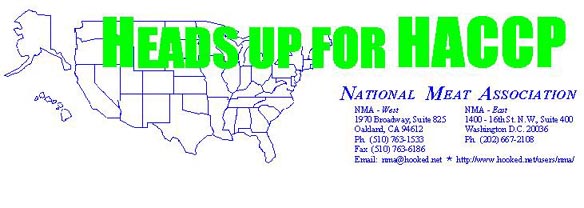

Edited by Jeremy Russell
January 5, 1998
HACCP PRINCIPLE #7: ESTABLISH VERIFICATION PROCEDURES
PRINCIPLE 6 OR 7? -- VERIFICATION
By Ranzell 'Nick' Nickelson, II
Director, International Food Safety, IDEXX Laboratories, Inc.
If you have studied HACCP for the past 25 years and subjected the seven principles to memory than you probably remember Principle 7 as Verification. If you track the changes that have been made in HACCP over the past few years you will now realize that Verification is Principle 6. The National Advisory Committee on Microbiological Criteria for Foods (NACMF) published a revised version of HACCP in August of 1997. Several changes were includes but one of the most noticeable was a flip-flopping of Principles 6 and 7. The NACMCF felt that the changes would be more consistent with the current HACCP guidance prepared by the Codex Committee on Food Hygiene (the International referee in food quality and safety issues). Since Verification records are an essential part of HACCP, the thought is that Verification takes place prior to Record Keeping. The old thought was that you could not do Verification unless you had Records to review. The bottom line is that you really can not separate any of the principles out of HACCP and the only important real world application is that you do them all the best you can, no matter the order.
Back to Verification. Verification is the fuel of HACCP. It is the Principle that keeps HACCP going and continues to make it better. Verification is defined in the new document "as those activities, other than monitoring, that determine the validity of the HACCP plan and that the system is operating according to the plan." The terms "Validation" and "Verification" are both used in the new HACCP document. Although these terms are often synonymous, it makes some sense to use validation for those functions that support the HACCP plan and to use verification when referring to the actions that support Principle 6. For example, the flow diagram that is a tool for the HACCP plan is calibrated by the HACCP team. The efficacy of Critical Control Points (CCPs) are validated by scientific research. The adequacy of the cleaning and sanitizing program can be validated by testing cleaned surfaces. The initial HACCP plan may be validated by an outside HACCP expert. And the HACCP plan is validated when changes in the process are implemented, when unexpected failures occur or when new hazards are identified.
Verification falls into two main categories. The first are the verification activities identified in the master HACCP plan to support each CCP. These activities include the review of CCP monitoring records, review of deviations and corrective action, sampling and testing, the calibration of thermometers and metal detectors. The second category are those verification activities that support the entire HACCP plan. These include extensive record reviews and are conducted by in-plant personnel, third-party experts or the regulatory agency. The regulatory agencies have developed checklists for inspectors to use in the conduct of regulatory verifications. All food processors should be familiar with those checklists.
The new HACCP document contains an Appendix G that provides Examples of Verification Activities. The first example is the establishment of appropriate verification schedules. An example of this schedule is also provided in the new document. The schedule details activities, frequency, responsibility and the reviewer. The HACCP verification schedule will become a part of the HACCP records. Remember, Record Keeping was Principle 6 but is now Principle 7!
NOTE:
In a letter to Secretary of Agriculture Dan Glickman, a coalition of eleven meat & poultry industry organizations, including the National Meat Association, has today demanded that due process procedures be included in the implementation of HACCP. (For more information see Herd on the Hill
1/5/98).